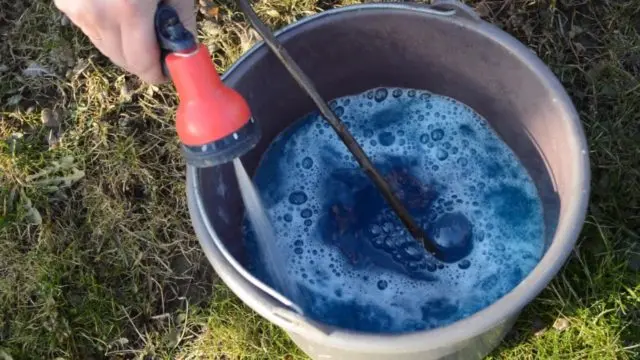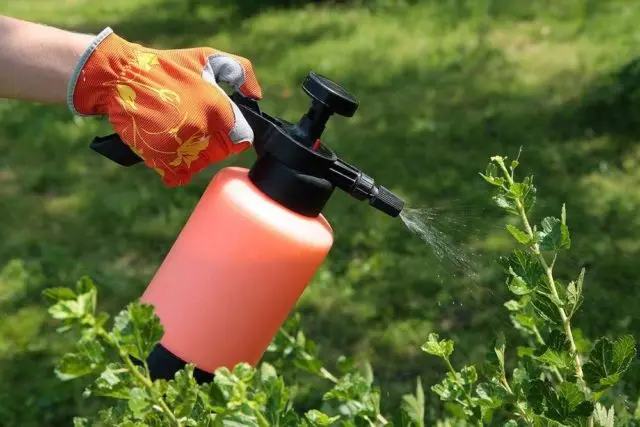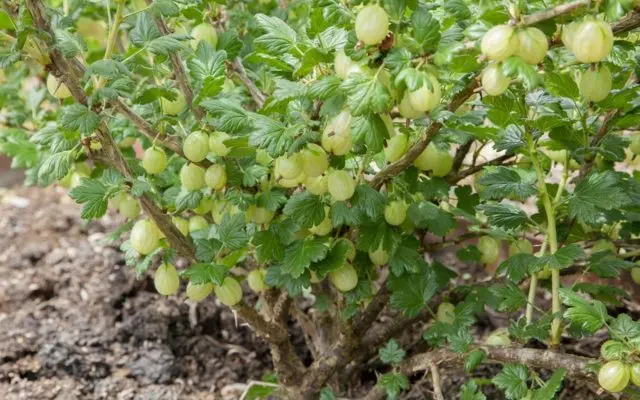Contents
Scab is a dangerous disease that affects berry and fruit bushes. Under certain conditions, gooseberries also suffer from it. To save the bush, it is necessary to start processing it in time. Control measures for scab on gooseberries will help get rid of the disease and save the crop.
What is “scab” on gooseberries
Scab, like any disease, appears under the influence of a number of factors. There are signs by which a lesion is diagnosed. The sooner a disease is detected, the easier it is to deal with it.
Symptoms and causes of infection
Scab is spread by microscopic fungi and bacteria. The disease is diagnosed not only on the gooseberry, but also on the apple tree, pear, potato, beet. Pathogens differ for each plant species. However, the signs of damage are similar for all cultures.
Most often, scab appears in the middle lane in temperate climates. The development of the disease is favored by cold and wet weather. The causative agent hibernates on fallen fruits and leaves. In spring, spores germinate into the leaf blade, but do not penetrate deeply. Tops of young shoots are most susceptible to damage.
Secondary infection is observed after 2-3 weeks. It spreads at an air temperature of +20 °C. During this period, light olive spots appear on the leaves, which gradually turn brown and crack.
Common signs of scab on gooseberries:
- brown spots on leaves, ovaries and shoots;
- green and brown growths on fruits;
- shrub sheds leaves ahead of time;
- peeling on leaves and berries;
- fruit deformation.
Photo of scab on gooseberries:

The appearance of scab on gooseberries is facilitated by:
- High soil moisture. Germination of fungal spores occurs when exposed to moisture. In the spring they spread after the snow melts, in the summer – due to rains, morning dew and fogs.
- Planting density. At risk are bushes growing too close to each other. Scab also develops in plants that have not been pruned. With thickening, favorable conditions are created for the disease – high humidity and lack of sun.
- Weak plant immunity. Certain varieties of gooseberries are more susceptible to the disease.
What is dangerous disease
All above-ground parts of the gooseberry suffer from scab: young shoots, leaves and berries. As a result, the fruits become smaller and deformed. They contain less vitamins and other useful substances, lose their taste and become unsuitable for consumption. With a serious damage to the crop, you can completely lose the crop.
How can you spray gooseberries from scab
To combat scab, use chemicals or folk remedies. The choice of a specific method depends on the degree of damage, the age of the bush and the season.
How to deal with scab on gooseberries with fungicides
The most reliable way to get rid of a harmful fungus is the use of chemicals. The most effective products containing copper or biological components. They are diluted with water to obtain a working solution. The bush is sprayed in cloudy weather or in the evening when there is no direct sunlight. Processing is carried out no later than 2 weeks before harvest.

When using fungicidal preparations, precautions are taken. To do this, do not allow their contact with the skin and mucous membranes. Children and animals are also removed from the place of processing. It is recommended to wear personal protective equipment for work.
Effective preparations for scab on gooseberries:
- Bordeaux liquid. A universal treatment option for gooseberries against fungal diseases. The tool is prepared from copper sulfate and lime. The working solution is valid for 30 days.
- Phytosporin-M. A biological drug that inhibits the reproduction of the fungus. In addition, it additionally stimulates the gooseberry immunity and accelerates its growth. Processing is carried out in several stages: before and after flowering, at the beginning of fruit formation.
- Is fast. Systemic fungicide that protects the garden from various lesions. The drug Skor is used at many stages of the vegetation of the bush: when the first buds appear, flowering, fruit growth. Phytotoxicity of the product is completely absent. Processing is carried out with an interval of 2 weeks.
- Raek. A systemic preparation that penetrates into plant tissues and destroys a harmful fungus. It has a long-term effect and prevents secondary infection. The first spraying is carried out when the gooseberry blossoms and is repeated after 15 days.
How to get rid of scab on gooseberries in folk ways
The main advantage of folk methods lies in their environmental friendliness, safety for plants and humans. Such funds have no restrictions on their use. All the necessary components are simple and commercially available. On their basis, a solution is prepared with which the bush is sprayed.

Folk remedies for scab on gooseberries:
- Mustard infusion. 10 g of powder is added to 100 liters of water.
- Brine. Dissolve 1 kg of salt in a large bucket of water. At the same time, do not allow the product to enter the soil, as this will worsen its properties.
- Wood ash infusion. 5 g of ash is added to 200 liters of water. The components are mixed and infused for a day. They also practice dusting gooseberries with ash.
- Horsetail infusion. To prepare the product, fresh horsetail is collected and 1/3 of the container is filled with it. Then pour water and leave the product for 3 days in a warm place. Filter the liquid before use.
Preventive measures
To avoid scab on gooseberries, it is necessary to follow agricultural practices. With comprehensive care, bushes rarely suffer from fungal diseases. This includes the regulation of watering and fertilizing. At the same time, they try to prevent excess moisture in the soil. Be sure to loosen the soil so that water does not accumulate in it. Good results are obtained by mulching the soil with straw or peat.
For feeding the bush in summer and autumn, potash and phosphorus compounds are chosen. Nitrogen preparations are used only in the spring, as they contribute to the growth of shoots. Complex top dressings increase plant immunity. Annually, the bush is inspected and cut dry, old, broken branches.
As an additional prevention of scab on gooseberries, it is recommended:
- use varieties resistant to diseases: Severyanin, Arlekin, Chernomor, Plum, etc .;
- choose healthy seedlings;
- maintain a distance between the bushes from 1 m;
- destroy fallen leaves in which fungal spores hibernate;
- in the fall, dig or loosen the soil.
The most reliable way to prevent gooseberry diseases is to perform preventive treatments. They begin in early spring after the snow melts. To fight diseases on gooseberries in the spring, use a solution of urea at a concentration of 5%. In the future, folk or chemical preparations are used. Spraying the culture with fungicides is carried out no more than once every 2 weeks.

Conclusion
Measures to combat scab on gooseberries involve the use of special preparations. They are selected taking into account the stage of vegetation and the condition of the bush. Preventive treatments and adherence to agricultural technology will help prevent the development of the disease in the future.









